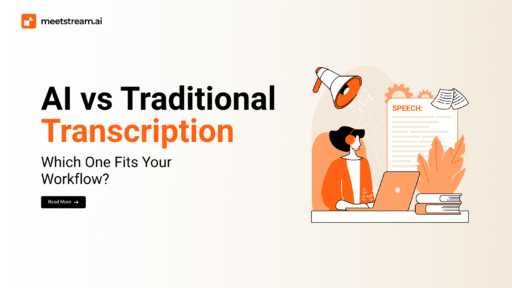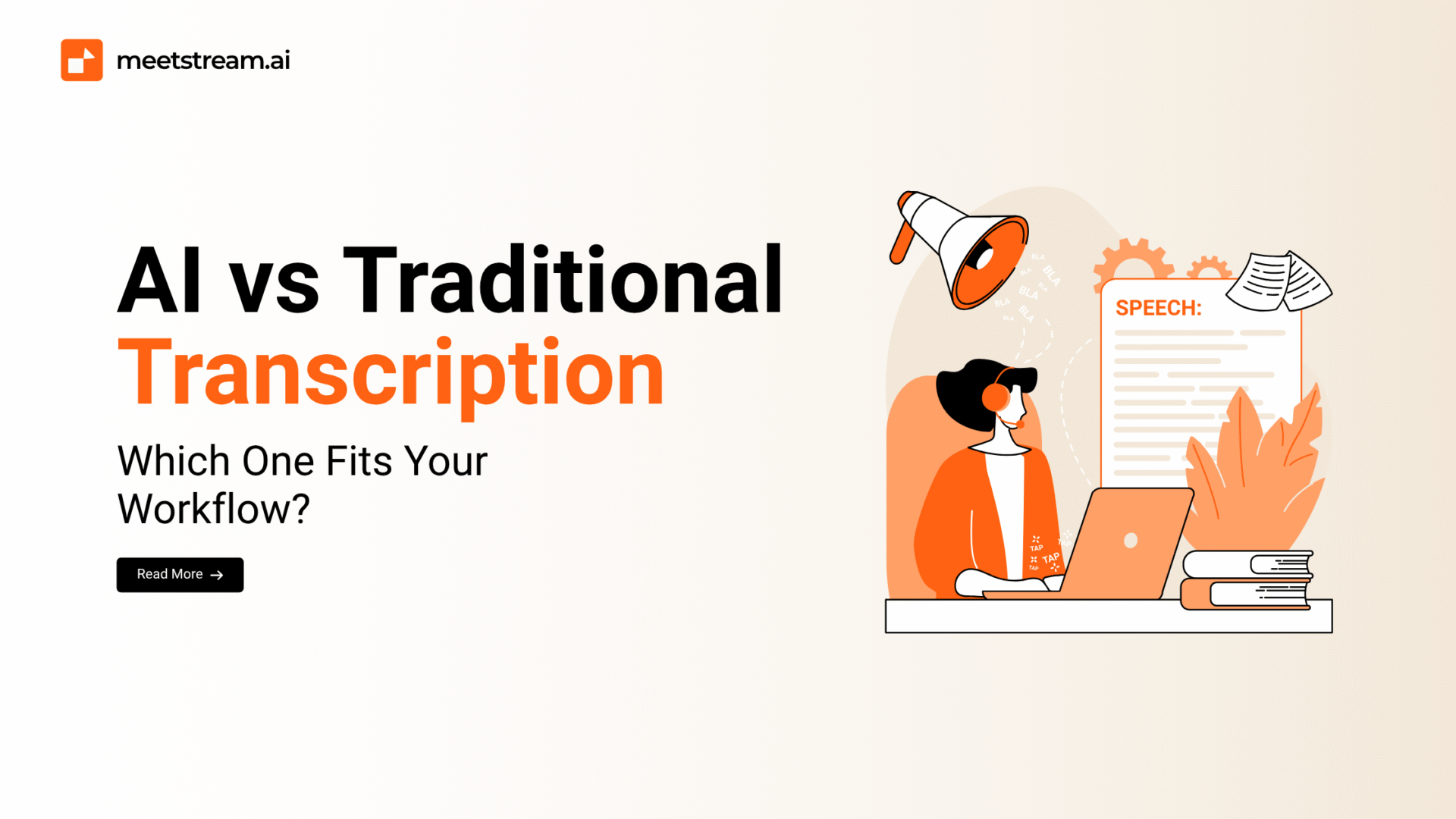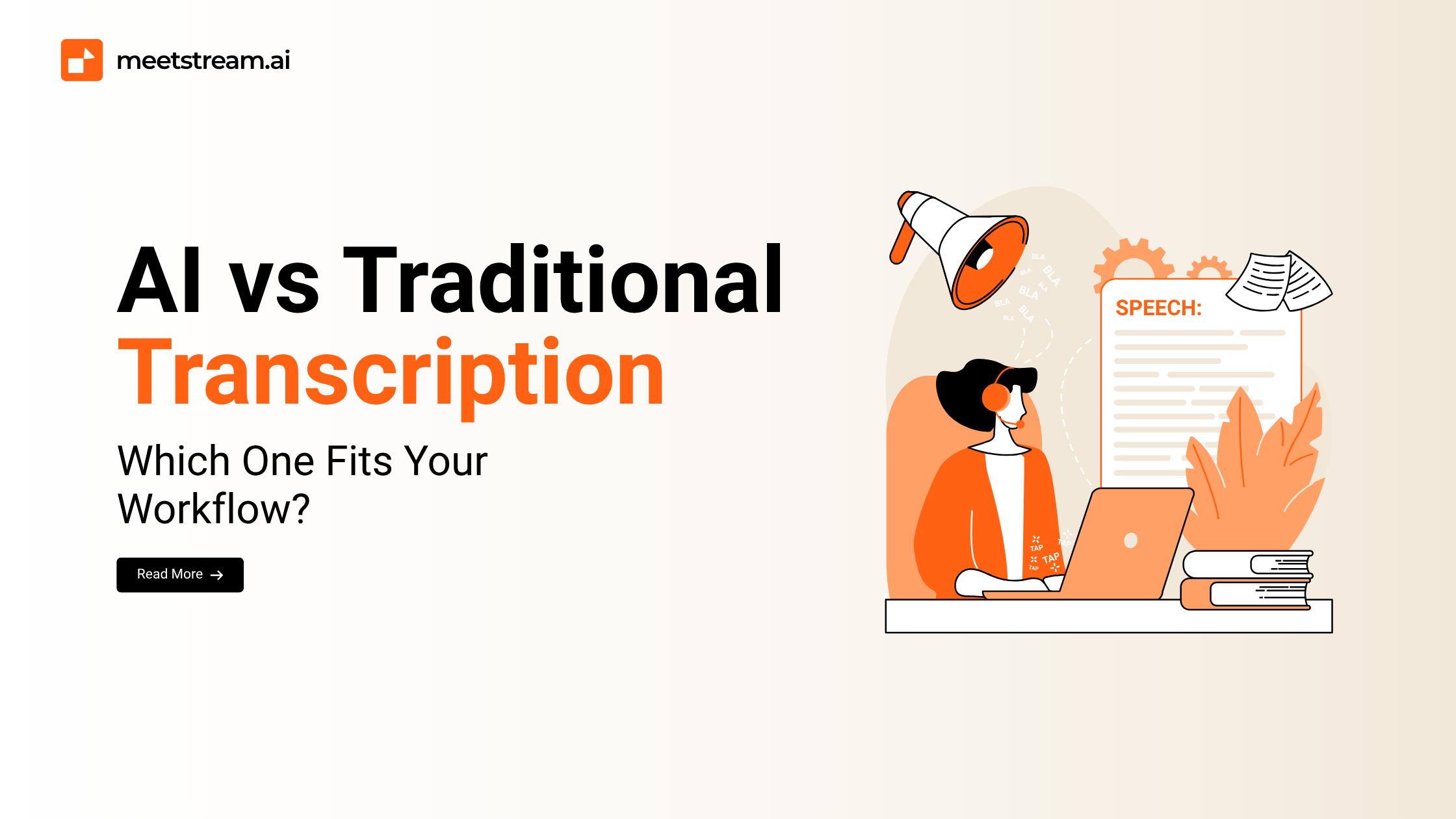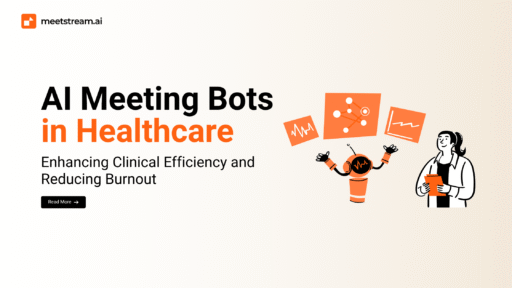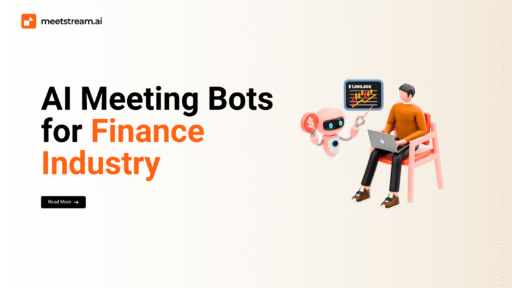In today’s fast-paced, hybrid work environment, capturing meeting insights accurately is essential for productivity, alignment, and faster decision-making.
Yet traditional note-taking often falls short—leading to missed details, miscommunication, and wasted time.
This blog dives into the strengths and limitations of AI-powered notetakers and human transcriptionists, showing how each works, where they excel, and when to use them.
You’ll discover practical use cases, comparison insights, and how to choose (or combine) the right approach to ensure every meeting drives action and results.
What is AI Notetakers?
AI notetakers—sometimes referred to as intelligent meeting assistants—leverage technologies like natural language processing (NLP), machine learning, and automated speech recognition (ASR) to handle the note-taking process from start to finish.
These systems can join video conferencing platforms such as Zoom, Microsoft Teams, or Google Meet, and perform real-time transcription, speaker labeling, summary generation, and task extraction without human intervention.
Modern platforms like Sharpen Notes, Otter.ai, offer advanced integrations with collaboration tools such as Slack, Notion, Asana, or CRM systems. The core value of AI notetakers lies in their ability to offload the repetitive, time-consuming aspects of meeting documentation, helping teams focus on meaningful collaboration instead of capturing every word.
The typical AI notetaking workflow involves several stages. First, the system records the meeting audio, either through a virtual meeting bot or a user-installed app. Next, it transcribes the conversation in real time using advanced voice-to-text algorithms.
Then, it performs speaker diarization, identifying who spoke when and tagging comments accordingly. Following that, the AI uses NLP techniques to generate structured summaries, extract key discussion points, and identify action items.
Finally, the content is pushed to relevant destinations—calendars, emails, project management dashboards—ensuring insights are preserved and accessible.
This entire process often completes within minutes, offering teams fast, automated meeting intelligence. Compared to manual note-taking, the speed, scalability, and workflow integration of AI notetakers make them especially appealing for high-volume or fast-moving teams.
What is Human Notetakers?
Human notetaking, whether conducted by in-person scribes, remote transcriptionists, or live minute-takers, brings its own distinct strengths to the table. Unlike automated systems, humans bring judgment, experience, and emotional intelligence into their transcription work—qualities that are especially important in complex, high-stakes, or sensitive meetings.
Professional notetakers listen closely not only to what’s said, but also how it’s said. They apply discretion, understand conversational nuance, and tailor summaries to reflect tone, context, and intent. This interpretive ability is particularly valuable in board meetings, HR reviews, legal consultations, or any setting where tone, subtext, or interpersonal dynamics carry weight.
Instead of relying solely on automation, human notetakers may use shorthand, live typing, or transcription software during the meeting, followed by a post-processing phase where they refine the content into polished notes. The result is a well-structured, context-aware record that reflects both facts and the spirit of the conversation.
Some unique strengths of human transcription include the ability to:
- Grasp emotional tone, sarcasm, hesitation, or humor—elements often lost on AI.
- Handle technical jargon, strong accents, or poor audio quality with better accuracy.
- Interpret overlapping or fast-paced dialogue with logical sequencing.
- Provide confidentiality and discretion in sensitive discussions, especially under NDAs.
- Foster trust and psychological comfort during vulnerable or sensitive meetings.
In environments where accuracy, discretion, and emotional awareness are non-negotiable, human transcriptionists continue to be the gold standard.
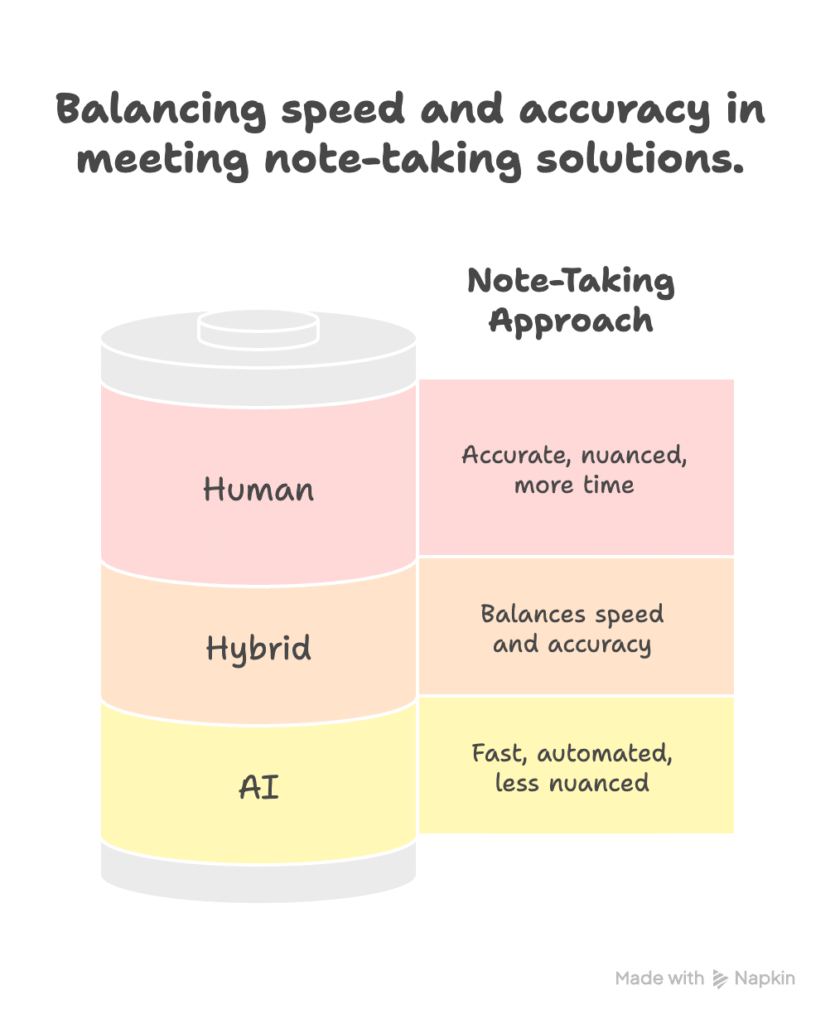
AI Notetakers vs Human Notetakers: A Detailed Comparison
When it comes to capturing critical meeting insights, organizations today face a key decision: AI notetakers vs human notetakers.
While both aim to record, summarize, and distill conversations into usable knowledge, their capabilities diverge significantly across accuracy, speed, cost, privacy, and automation.
Let’s dive deeper into how these two approaches compare—so you can decide which fits your workflow, budget, and compliance needs.
1. Accuracy & Context Understanding
AI transcription engines typically achieve 80–95% accuracy under ideal conditions—quiet environments, clear speech, and standard accents. However, they may struggle with overlapping dialogue, strong accents, technical jargon, or nuances like sarcasm and irony.
Human transcriptionists often exceed 99% accuracy. They’re trained to detect tone, interpret ambiguous phrases, and understand emotional cues—especially useful in contexts like therapy, legal, or HR meetings where subtlety matters.
Humans outperform AI in understanding the broader context. For instance, distinguishing between a rhetorical remark and a serious statement requires empathy and world knowledge—areas where AI still lags, even with advancements in large language models.
2. Speed & Turnaround Time
AI tools deliver real-time transcription and automated summaries, often within seconds to minutes after a call ends. This immediacy makes them ideal for fast-paced environments where quick action is critical.
Human notetakers, by contrast, require time to polish transcripts—correcting grammar, ensuring coherence, and formatting for readability. Depending on the session length and complexity, turnaround times can range from a few hours to 24+ hours.
Use Case Insight: AI wins on speed for internal reviews and team syncs. Human notetaking shines in client-facing documentation or legal proceedings that demand precision.
3. Cost & Scalability
| Factor | AI Notetakers | Human Notetakers |
| Pricing Model | Subscription-based ($10–$20/month) | Pay-per-minute/hour ($1–$3/min) |
| Scalability | High — supports unlimited meetings | Limited — constrained by available staff |
| Volume Capacity | Easily handles daily standups and webinars | Ideal for high-stakes or complex sessions |
For teams conducting multiple meetings daily, AI notetakers offer a cost-effective, scalable solution. However, for critical contexts like board meetings, investor calls, or compliance reviews, the human touch justifies the premium.
4. Privacy & Security
Most leading solutions come with end-to-end encryption, secure cloud storage, and compliance with major standards such as GDPR, HIPAA, CCPA, and SOC 2.
But despite these protections, risks around data residency, unauthorized access, or API misconfigurations can persist.
When vetted properly, human notetakers often work under strict NDAs and can operate within air-gapped, offline environments for added protection.
Their discretion and controlled access make them a preferred option for sensitive HR cases, confidential legal discussions, or clinical consultations.
Pro Tip: Always verify whether your AI vendor offers on-premise deployment or regional data storage options if data sovereignty is critical.
5. Integration & Automation
AI-based solutions integrate effortlessly with tools like Google Calendar, Zoom, Slack, Salesforce, and Asana—automating everything from meeting invites to follow-up tasks. This seamless connectivity allows AI to become a core part of your productivity stack.
Human workflows, while adaptable, require manual steps—file transfers, handover emails, or formatting tasks—which slows down feedback loops and increases dependency on individual availability.
If you’re optimizing for speed, automation, and collaboration, AI tools fit naturally into modern remote-first workflows.
For teams that want the flexibility to build their own meeting assistant rather than rely on fixed, off-the-shelf tools, solutions like Meetstream.ai offer a powerful foundation.
Its developer-friendly API lets you integrate real-time transcription, summarization, action item extraction, and workflow syncing directly into your own platform or internal tools—perfect for creating a meeting bot tailored to your exact processes and security requirements.
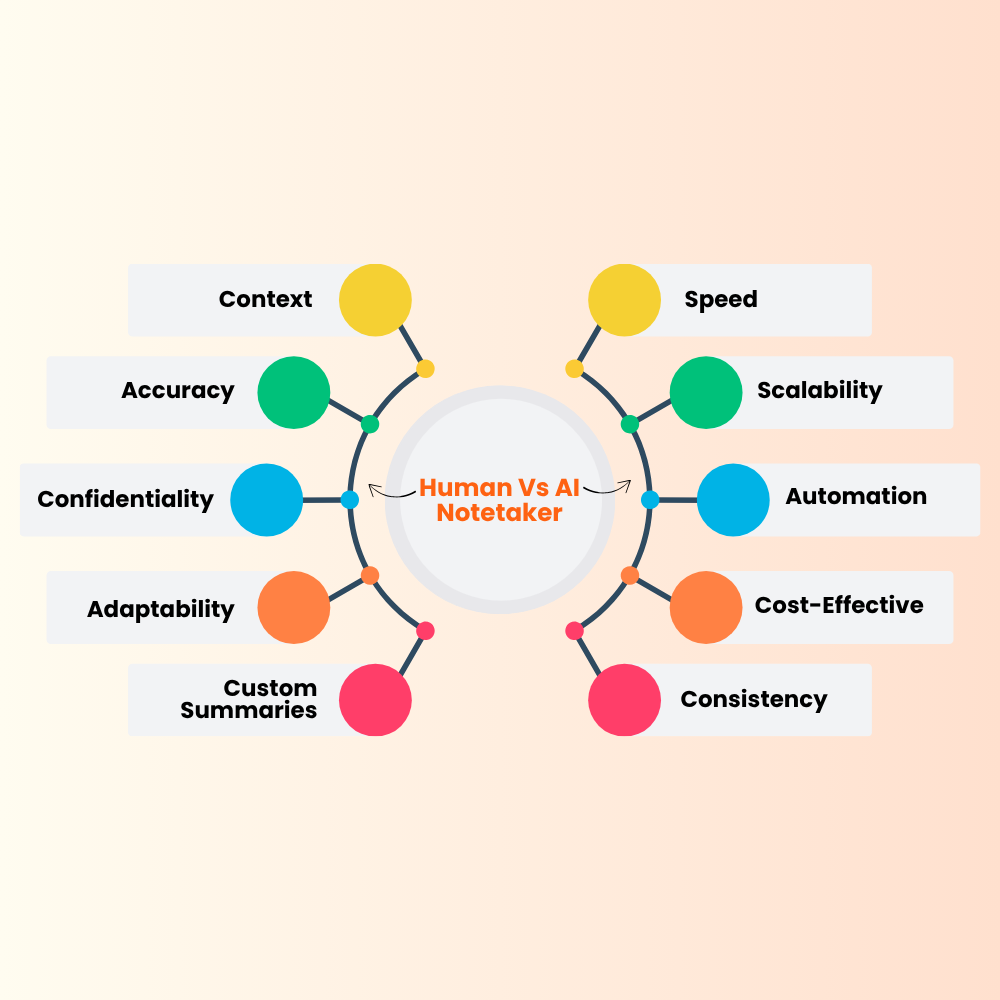
Use Cases: When to Choose AI vs Human Notetakers
Choosing between AI and human notetaking isn’t about which is better—it’s about what fits best. Depending on the context, stakes, and sensitivity of your meetings, the right choice may vary. Here’s a practical guide to help you decide.
Best Scenarios for AI Notetaking
AI notetakers shine in fast-paced, high-volume environments where speed, structure, and integration matter more than emotional nuance.
- Daily Standups: Perfect for short, structured updates where turnaround time matters more than depth.
- Training Sessions / Webinars: Best for capturing instructional content in environments with moderate confidentiality.
- Sales Calls: AI can instantly generate summaries, log CRM entries, and assign action items—ideal for sales ops automation.
- Content-Creation Meetings: Use AI to quickly draft blog outlines, video scripts, or brainstorm notes for marketing teams.
- Team Syncs & Project Check-Ins: Useful when rapid recap and action item distribution are prioritized over conversational nuance.
When Human Notetaking Makes More Sense?
There are times when only a human can truly grasp the emotional weight, context, or sensitivity of a conversation.
Legal Proceedings: Requires exact transcripts and often formal certification for legal admissibility.
- Investor or Executive Board Meetings: Involves strategic discussions where confidentiality and nuance are paramount.
- HR & Compliance Discussions: Sensitive topics—such as employee concerns or regulated disclosures—benefit from empathetic and confidential handling.
- Therapy or Mental Health Sessions: Capturing emotional tone, subtle shifts, and trust-driven dialogue is essential.
- Highly Confidential or Sensitive Content: In domains like defense, biotech, or internal executive planning, discretion beats automation.
Tip: Align your notetaking method with the meeting’s level of formality, confidentiality, and consequence.
The Rise of Hybrid Approaches
More teams are blending AI automation with human judgment to create efficient, context-aware workflows.
Combining AI Speed with Human Insight
Here’s what a modern hybrid notetaking workflow looks like:
- AI records and transcribes the meeting, generating the first draft along with summaries and key takeaways.
- Human editor reviews the output to:
- Clarify ambiguous phrasing
- Add context or emotional nuance
- Fix speaker attribution or technical terms
- Finalize notes for external stakeholders
- Clarify ambiguous phrasing
Why Go Hybrid?
- Cuts down editing time compared to full human transcription
- Adds nuance and quality AI alone can’t deliver
- Offers balance between cost, speed, and accuracy
Platforms like Rev now offer human QA layers on top of AI-generated transcripts. Others use AI summaries with human verification for critical content—especially for legal or compliance purposes.
Key Takeaway
Choosing between AI and human notetakers isn’t about which is universally better—it’s about matching the method to the meeting.
AI offers unmatched speed, scalability, and automation, making it perfect for high-volume, fast-moving teams. Human notetakers bring context, emotional intelligence, and discretion, which are critical for sensitive or high-stakes conversations.
Many organizations are now finding that a hybrid approach delivers the best of both worlds—AI for rapid capture and automation, paired with human insight for nuance and accuracy.
If you’re looking to create a tailored solution that fits your exact workflow, Meetstream.ai provides the API infrastructure to build custom meeting bots capable of real-time transcription, summarization, task extraction, and secure integrations—helping you combine speed, accuracy, and adaptability in one seamless process.
FAQs About AI and Human Notetakers
Are AI notetakers accurate for regional accents?
Accuracy varies, strong accents or dialects may degrade performance. Humans remain superior at understanding voice nuance across regions.
Can AI understand multiple speakers at once?
Yes, modern AI can perform multi-speaker differentiation, but accuracy drops when people talk over each other. Humans still handle overlapping speech better.
Are human note-takers bound by NDAs?
Yes, professional transcription services typically operate under strict confidentiality agreements, making them suitable for sensitive settings.
Ready to transform your meeting process?
Human notetaking generally offers stronger data protection. However, if your AI tool has robust security (e.g., encryption, GDPR/HIPAA compliance), it may suffice especially in a hybrid model.

